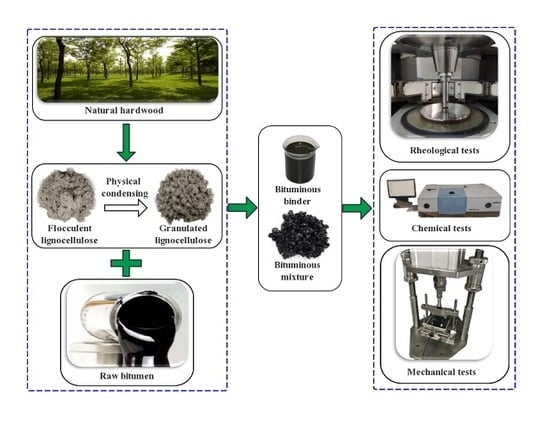Laboratory Investigation of Lignocellulosic Biomass as Performance Improver for Bituminous Materials
Abstract
1. Introduction
2. Materials and Methods
2.1. Materials and Sample Preparation
2.1.1. Materials
2.1.2. Sample Preparation
2.2. Testing Program
2.2.1. Penetration and Softening Point
2.2.2. Rotational Viscosity
2.2.3. Performance grade (PG) in Superpave Specification
2.2.4. Other Viscoelastic Properties
2.2.5. Molecular Weight Distribution
2.2.6. Fourier-Transform Infrared Spectroscopy (FTIR)
2.2.7. Marshall Stability and Flow Value
2.2.8. Moisture Susceptibility
2.2.9. Indirect Tensile Stiffness Modulus
3. Results and Discussion
3.1. Rheological Tests
3.1.1. Empirical Parameters
3.1.2. Workability
3.1.3. Rutting Resistance
3.1.4. Fatigue Resistance
3.1.5. Low Temperature Performance
3.1.6. Overall Rheological Behavior
3.2. Chemical Tests
3.2.1. Molecular Weight Distribution
3.2.2. Fourier-Transform Infrared Spectroscopy
3.3. Mixture Test
3.3.1. Marshall Stability and Flow Value
3.3.2. Indirect Tensile Strength and Moisture Susceptibility
3.3.3. Stiffness Modulus and Aging Resistance
4. Conclusions
- (1)
- Interaction between lignocellulosic biomass and bituminous binder can be observed.
- (2)
- Lignocellulosic biomass has a slightly negative effect on the workability of bitumen. But lignocellulosic biomass modified binders still meet the viscosity requirements in Superpave specification at 135 °C.
- (3)
- The incorporation of lignocellulosic biomass helps improve the overall service performance of bituminous binder in high, intermediate and low temperatures.
- (4)
- Bituminous mixtures with lignocellulosic biomass modifier binder have superior resistance to rutting and moisture damage. The effect of lignocellulosic biomass on aging resistance is not significant.
Author Contributions
Funding
Conflicts of Interest
References
- Hendriks, A.T.W.M.; Zeeman, G. Pretreatments to enhance the digestibility of lignocellulosic biomass. Bioresour. Technol. 2009, 100, 10–18. [Google Scholar] [CrossRef] [PubMed]
- Ciolacu, D.; Ciolacu, F.; Popa, V.I. Amorphous cellulose-structure and characterization. Cell Chem. Technol. 2011, 45, 13–21. [Google Scholar]
- Pérez, J.; Muñoz-Dorado, J.; de la Rubia, T.; Martínez, J. Biodegradation and biological treatments of cellulose, hemicellulose and lignin: an overview. Int. Microbiol. 2002, 5, 53–63. [Google Scholar] [CrossRef] [PubMed]
- Rinaldi, R.; Jastrzebski, R.; Clough, M.T.; Ralph, J.; Kennema, M.; Bruijnincx, P.C.A.; Weckhuysen, B.M. Paving the way for lignin valorisation: Recent advances in bioengineering, biorefining and catalysis. Angew. Chem. Int. Ed. 2016, 55, 8164–8215. [Google Scholar] [CrossRef] [PubMed]
- Mishra, P.K.; Wimmer, R. Aerosol assisted self-assembly as a route to synthesize solid and hollow spherical lignin colloids and its utilization in layer by layer deposition. Ultrason. Sonochem. 2017, 3, 40–45. [Google Scholar] [CrossRef] [PubMed]
- Pawan, K.M.; Adam, E. The self-assembly of lignin and its application in nanoparticle synthesis: A short review. Nanomaterials 2019, 9, 243. [Google Scholar] [CrossRef]
- Karade, S.R. Cement-bonded composites from lignocellulosic wastes. Constr. Build. Mater. 2010, 24, 1323–1330. [Google Scholar] [CrossRef]
- Yang, Z.; Zhang, X.; Zhang, Z.; Zou, B.; Zhu, Z.; Lu, G.; Xu, W.; Yu, J.; Yu, H. Effect of aging on chemical and rheological properties of bitumen. Polymers 2018, 10, 1345. [Google Scholar] [CrossRef] [PubMed]
- Han, M.; Zeng, X.; Muhammad, Y.; Li, J.; Yang, J.; Yang, S.; Wei, Y.; Meng, F. Preparation of octadecyl amine grafted over waste rubber powder (ODA-WRP) and properties of its incorporation in SBS-modified asphalt. Polymers 2019, 11, 665. [Google Scholar] [CrossRef]
- Li, J.; Han, M.; Muhammad, Y.; Liu, Y.; Su, Z.; Yang, J.; Yang, S.; Duan, S. Preparation and properties of sbs-g-gos-modified asphalt based on a thiol-ene click reaction in a bituminous environment. Polymers 2018, 10, 1264. [Google Scholar] [CrossRef]
- Yu, H.; Leng, Z.; Zhou, Z.; Shih, K.; Xiao, F.; Gao, Z. Optimization of preparation procedure of liquid warm mix additive modified asphalt rubber. J. Cleaner Prod. 2017, 141, 336–345. [Google Scholar] [CrossRef]
- Ma, T.; Wang, H.; He, L.; Zhao, Y.; Huang, X.; Chen, J. Property characterization of asphalt and mixtures modified by different crumb rubbers. J. Mater. Civ. Eng. 2017, 29, 04017036. [Google Scholar] [CrossRef]
- Yu, H.; Leng, Z.; Dong, Z.; Tan, Z.; Guo, F.; Yan, J. Workability and mechanical property characterization of asphalt rubber mixtures modified with various warm mix asphalt additives. Constr. Build. Mater. 2018, 175, 392–401. [Google Scholar] [CrossRef]
- Yu, J.; Ren, Z.; Gao, Z.; Wu, Q.; Zhu, Z.; Yu, H. Recycled heavy bio oil as performance enhancer for rubberized bituminous binders. Polymers 2019, 11, 800. [Google Scholar] [CrossRef] [PubMed]
- Yu, H.; Zhu, Z.; Zhang, Z.; Yu, J.; Oeser, M.; Wang, D. Recycling waste packaging tape into bituminous mixtures towards enhanced mechanical properties and environmental benefits. J. Cleaner Prod. 2019, 229, 22–31. [Google Scholar] [CrossRef]
- Chen, H.; Xu, Q. Experimental study of fibers in stabilizing and reinforcing asphalt binder. Fuel 2010, 89, 1616–1622. [Google Scholar] [CrossRef]
- Xu, G.; Wang, H.; Zhu, H. Rheological properties and anti-aging performance of asphalt binder modified with wood lignin. Constr. Build. Mater. 2017, 151, 801–808. [Google Scholar] [CrossRef]
- Watkins, D.; Nuruddin, M.; Hosur, M.; Tcherbi-Narteh, A.; Jeelani, S. Extraction and characterization of lignin from different biomass resources. J. Mater. Res. Technol. 2015, 4, 26–32. [Google Scholar] [CrossRef]
- Abiola, O.S.; Kupolati, W.K.; Sadiku, E.R.; Ndambuki, J.M. Utilisation of natural fibre as modifier in bituminous mixes: A review. Constr. Build. Mater. 2014, 54, 305–312. [Google Scholar] [CrossRef]
- Banerjee, P.K.; Ghosh, M. Studies on jute–asphalt composites. J. Appl. Polym. Sci. 2008, 109, 3165–3172. [Google Scholar] [CrossRef]
- Chen, H.; Xu, Q.; Chen, S.; Zhang, Z. Evaluation and design of fiber-reinforced asphalt mixtures. Mater. Des. 2009, 30, 2595–2603. [Google Scholar] [CrossRef]
- McCready, N.S.; Williams, R.C. Utilization of biofuel coproducts as performance enhancers in asphalt binder. Transp. Res. Rec. 2008, 2051, 8–14. [Google Scholar] [CrossRef]
- Pan, T. A first-principles based chemophysical environment for studying lignins as an asphalt antioxidant. Constr. Build. Mater. 2012, 36, 654–664. [Google Scholar] [CrossRef]
- Batista, K.B.; Padilha, R.P.L.; Castro, T.O.; Silva, C.F.S.C.; Araújo, M.F.A.S.; Leite, L.F.M.; Pasa, V.M.D.; Lins, V.F.C. High-temperature, low-temperature and weathering aging performance of lignin modified asphalt binders. Ind. Crops Prod. 2018, 111, 107–116. [Google Scholar] [CrossRef]
- Arafat, S.; Kumar, N.; Wasiuddin, N.M.; Owhe, E.O.; Lynam, J.G. Sustainable lignin to enhance asphalt binder oxidative aging properties and mix properties. J. Cleaner Prod. 2019, 217, 456–468. [Google Scholar] [CrossRef]
- Xie, S.; Li, Q.; Karki, P.; Zhou, F.; Yuan, J.S. Lignin as renewable and superior asphalt binder modifier. ACS Sustain. Chem. Eng. 2017, 5, 2817–2823. [Google Scholar] [CrossRef]
- Home page of Changzhou Lubisi New Material Technology. Available online: www.lbsxcl.com/ (accessed on 18 April 2019).
- American Society for Testing and Materials. Standard test method for Marshall stability and flow of asphalt mixtures. In ASTM D6927–15; American Society for Testing and Materials: West Conshohocken, PA, USA, 2015. [Google Scholar]
- American Association of State and Highway Transportation Officials. Standard method of test for resistance of compacted asphalt mixtures to moisture-induced damage. In AASHTO Standard T. 283–07; Washington, DC, USA, American Association of State and Highway Transportation Officials, 2007. [Google Scholar]
- American Association of State and Highway Transportation Officials. Penetration of Bituminous Materials. In AASHTO T 49; American Association of State and Highway Transportation Officials: Washington, DC, USA, 2006. [Google Scholar]
- American Association of State and Highway Transportation Officials. Standard Test Method for Softening Point of Bitumen (Ring-and-Ball Apparatus). In AASHTO D 36; American Association of State and Highway Transportation Officials: Washington, DC, USA, 2010. [Google Scholar]
- American Association of State and Highway Transportation Officials. Viscosity Determination of Asphalt Binder Using Rotational Viscometer. In AASHTO T 316–13; American Association of State and Highway Transportation Officials: Washington, DC, USA, 2010. [Google Scholar]
- American Association of State and Highway Transportation Officials. Determining the flexural creep stiffness of asphalt binder using the bending beam rheometer (BBR). In AASHTO T 313; American Association of State and Highway Transportation Officials: Washington, DC, USA, 2012. [Google Scholar]
- American Association of State and Highway Transportation Officials. Standard Specification for Performance-Graded Asphalt Binder. In AASHTO Standard M320; American Association of State and Highway Transportation Officials: Washington, DC, USA, 2007. [Google Scholar]
- American Association of State and Highway Transportation Officials. Standard method of test for multiple stress creep recovery (MSCR) test of asphalt binder using a dynamic shear rheometer (DSR). In AASHTO TP 70–13; American Association of State and Highway Transportation Officials: Washington, DC, USA, 2009. [Google Scholar]
- American Association of State and Highway Transportation Officials. Standard method of test for estimating fatigue resistance of asphalt binders using the linear amplitude sweep. In AASHTO TP101; American Association of State and Highway Transportation Officials: Washington, DC, USA, 2010. [Google Scholar]
- British Standards Institution. BS EN 12697-26-Bituminous mixtures—Test methods for hot mix asphalt—Part 26: Stiffness; European Committee for Standardization (CEN): Brussels, Belgium, 2004. [Google Scholar]
- Yu, J.; Yu, X.; Gao, Z.; Guo, F.; Wang, D.; Yu, H. Fatigue resistance characterization of warm asphalt rubber by multiple approaches. Appl. Sci. 2018, 8, 1495. [Google Scholar] [CrossRef]
- Zhou, F.; Mogawer, W.; Li, H.; Andriescu, A.; Copeland, A. Evaluation of fatigue tests for characterizing asphalt binders. J. Mater. Civ. Eng. 2013, 25, 610–617. [Google Scholar] [CrossRef]
- Tang, N.; Lv, Q.; Huang, W.; Lin, P.; Yan, C. Chemical and rheological evaluation of aging characteristics of terminal blend rubberized asphalt binder. Constr. Build. Mater. 2019, 205, 87–96. [Google Scholar] [CrossRef]

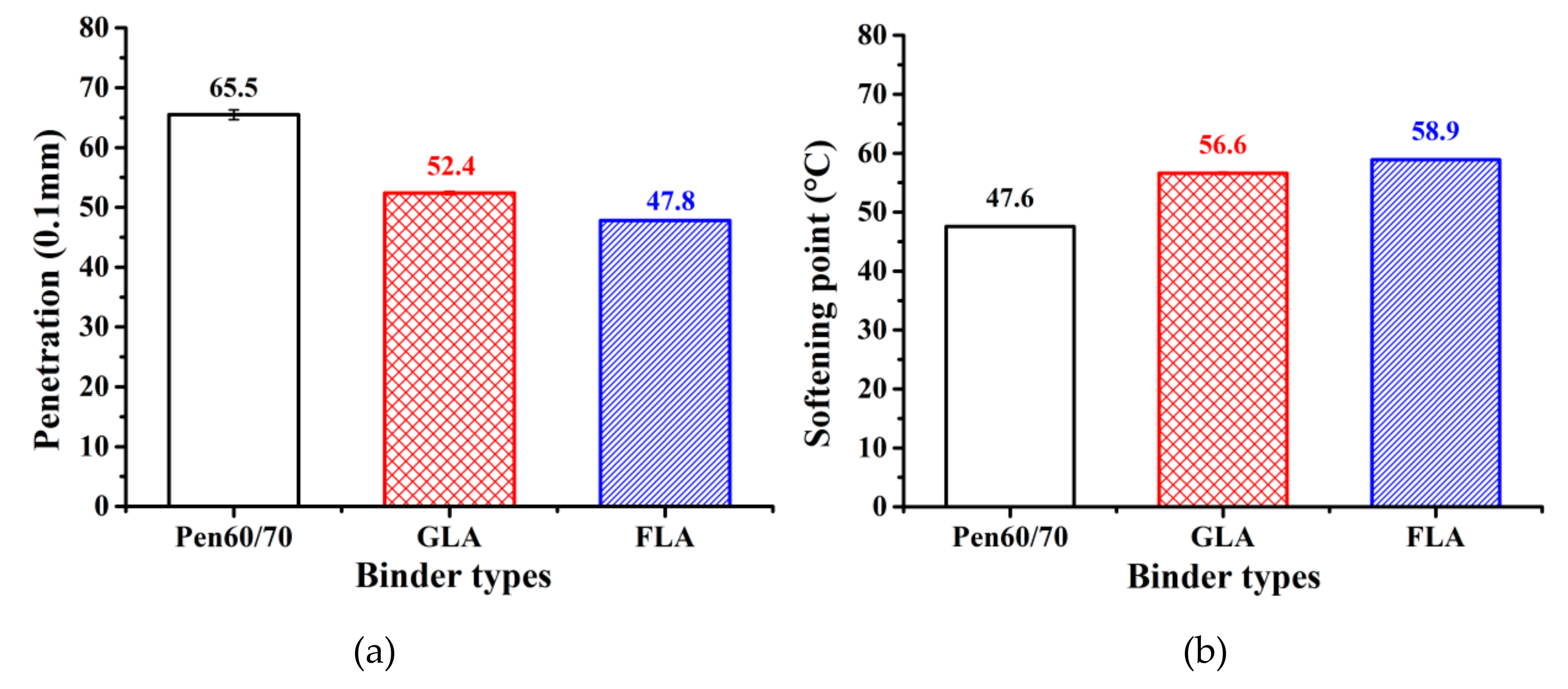

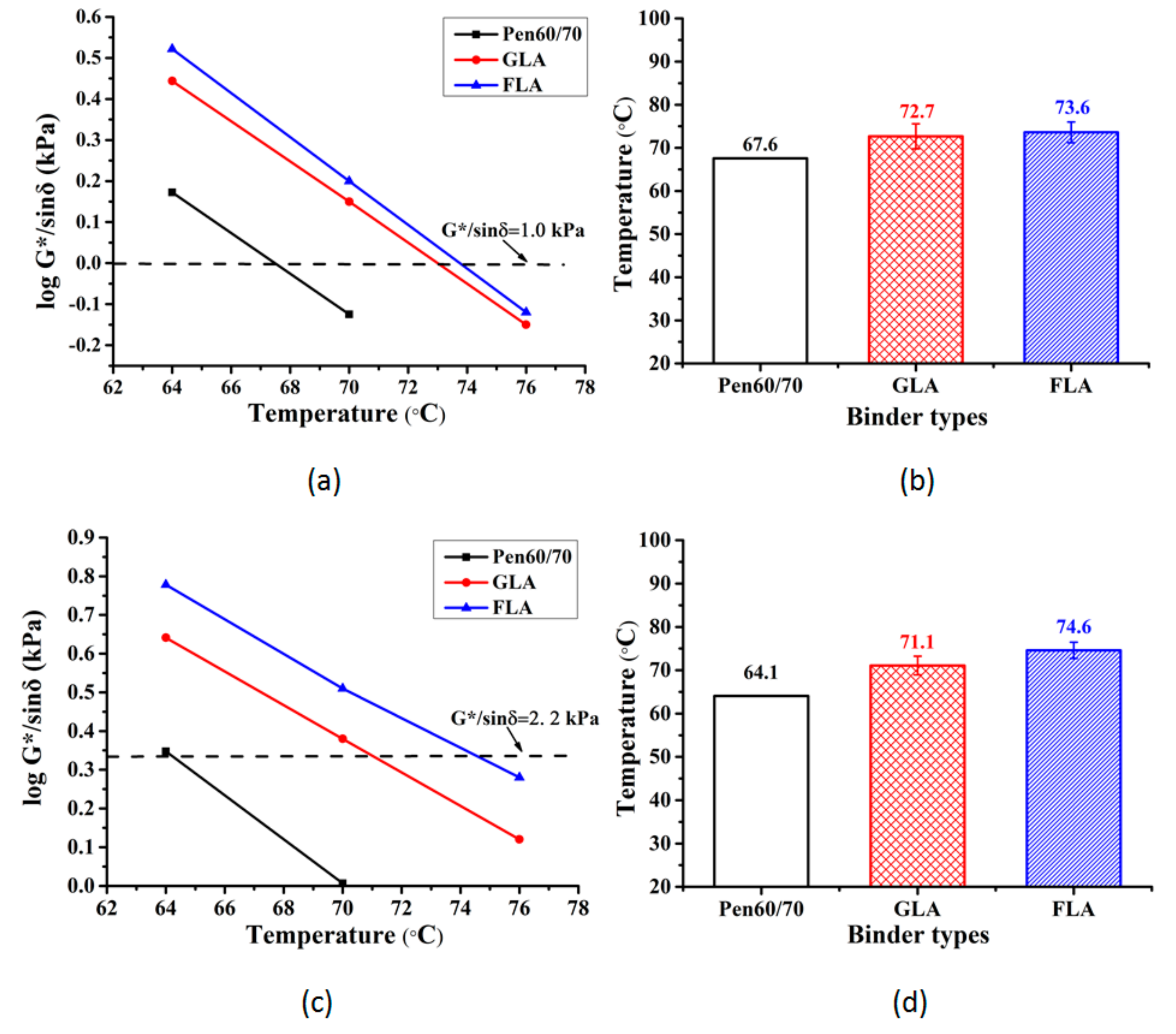

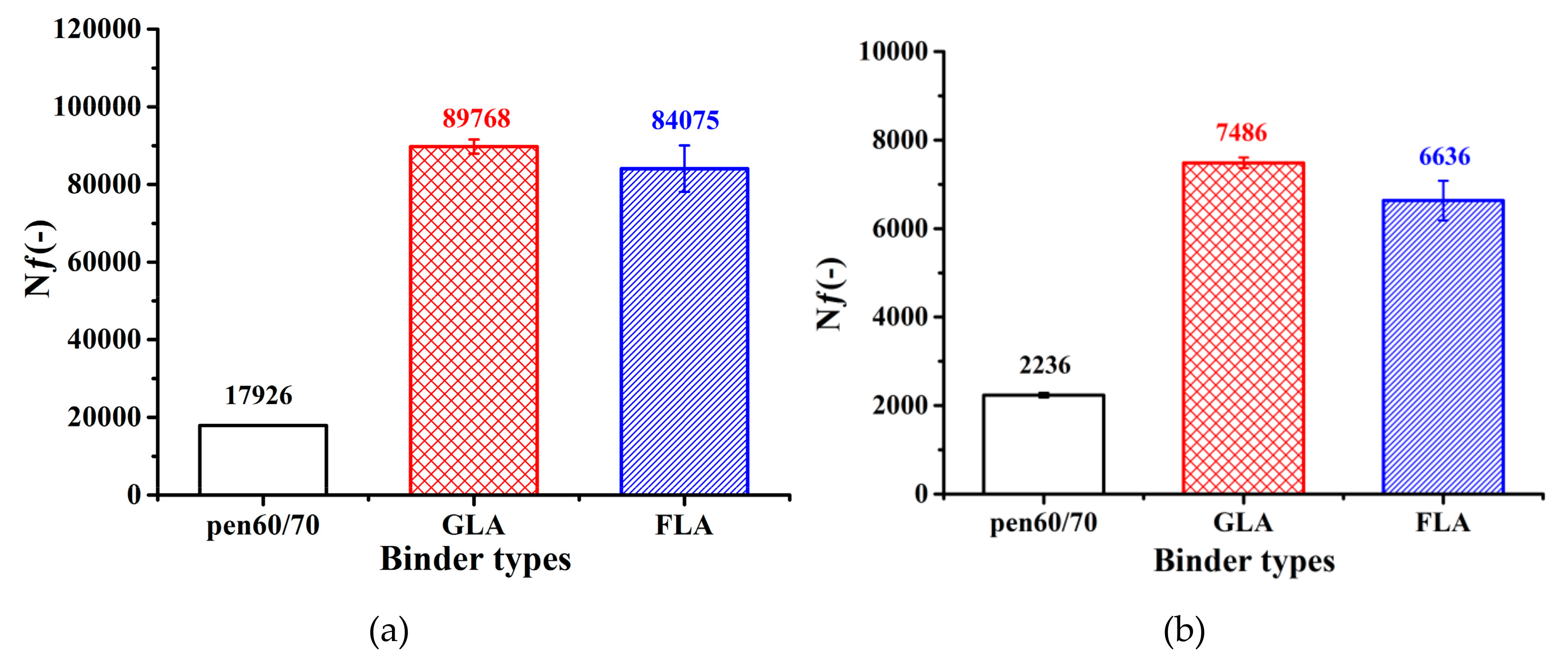
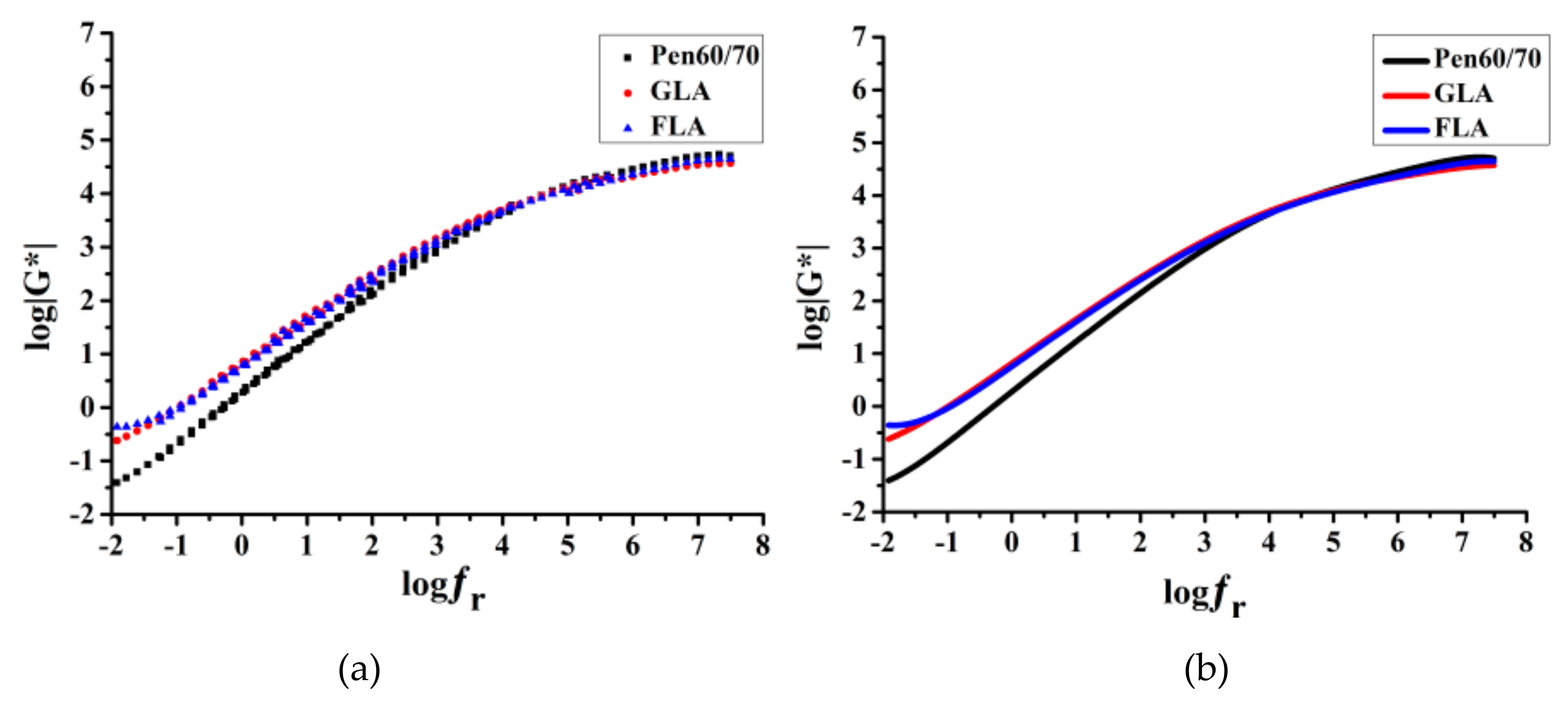
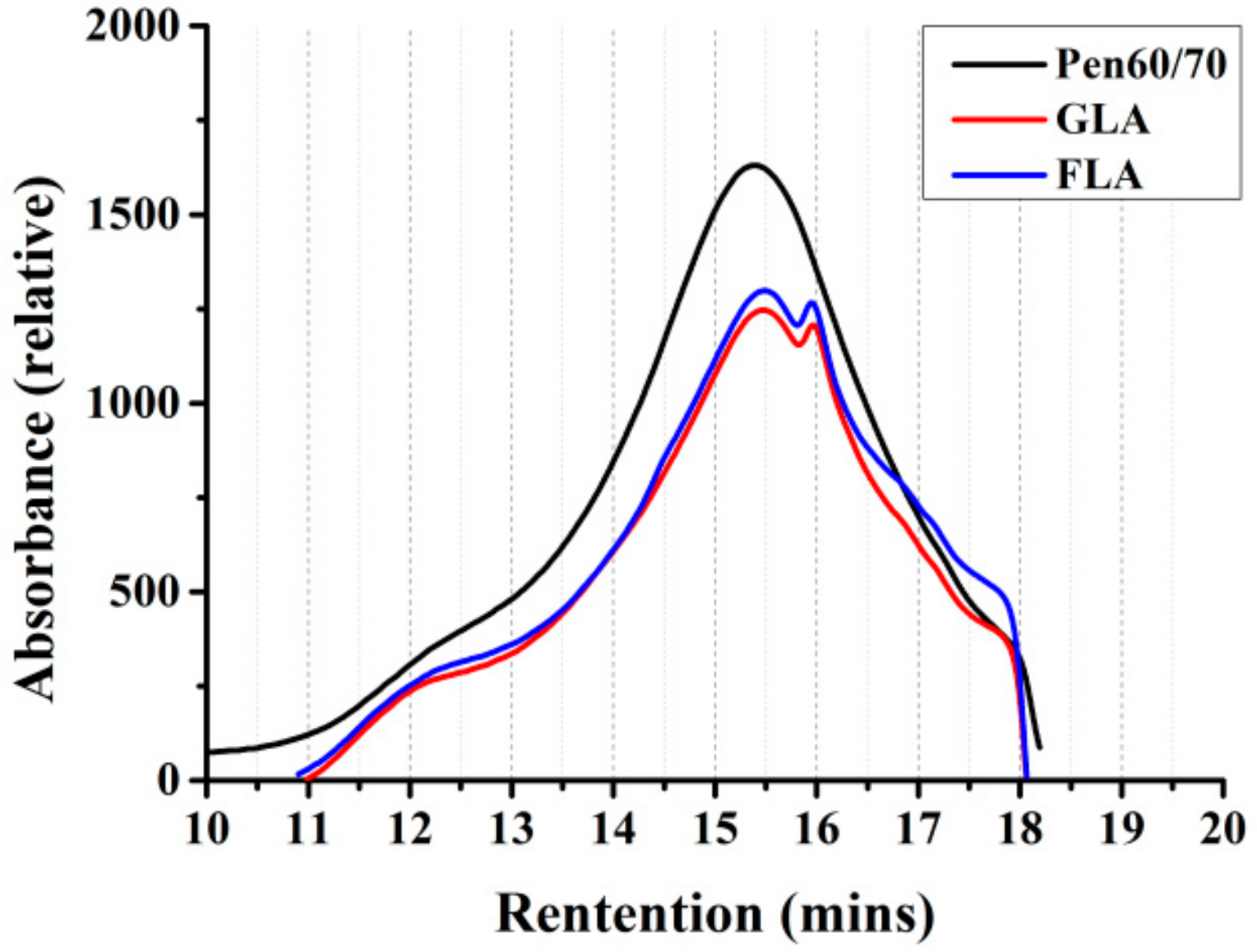

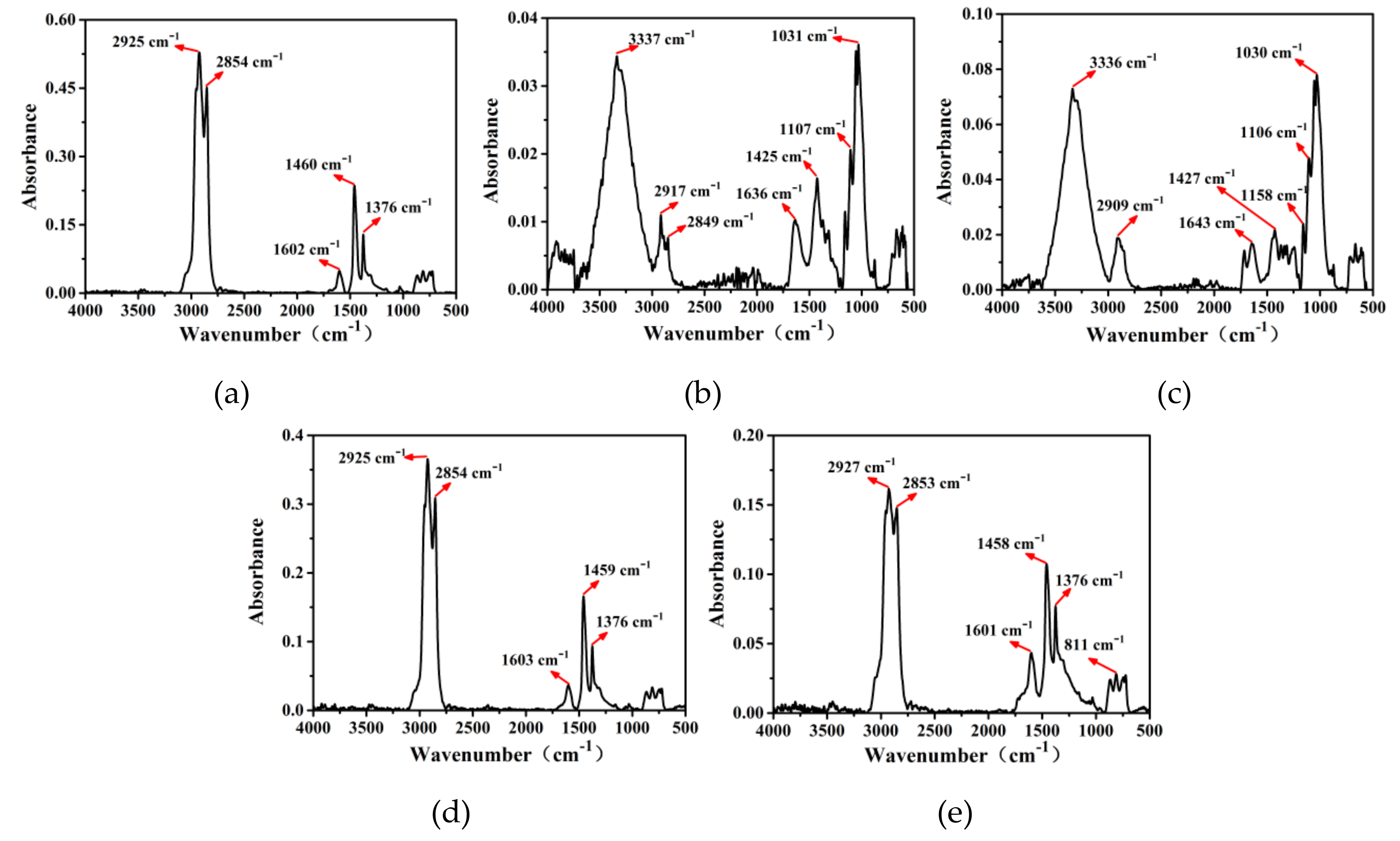
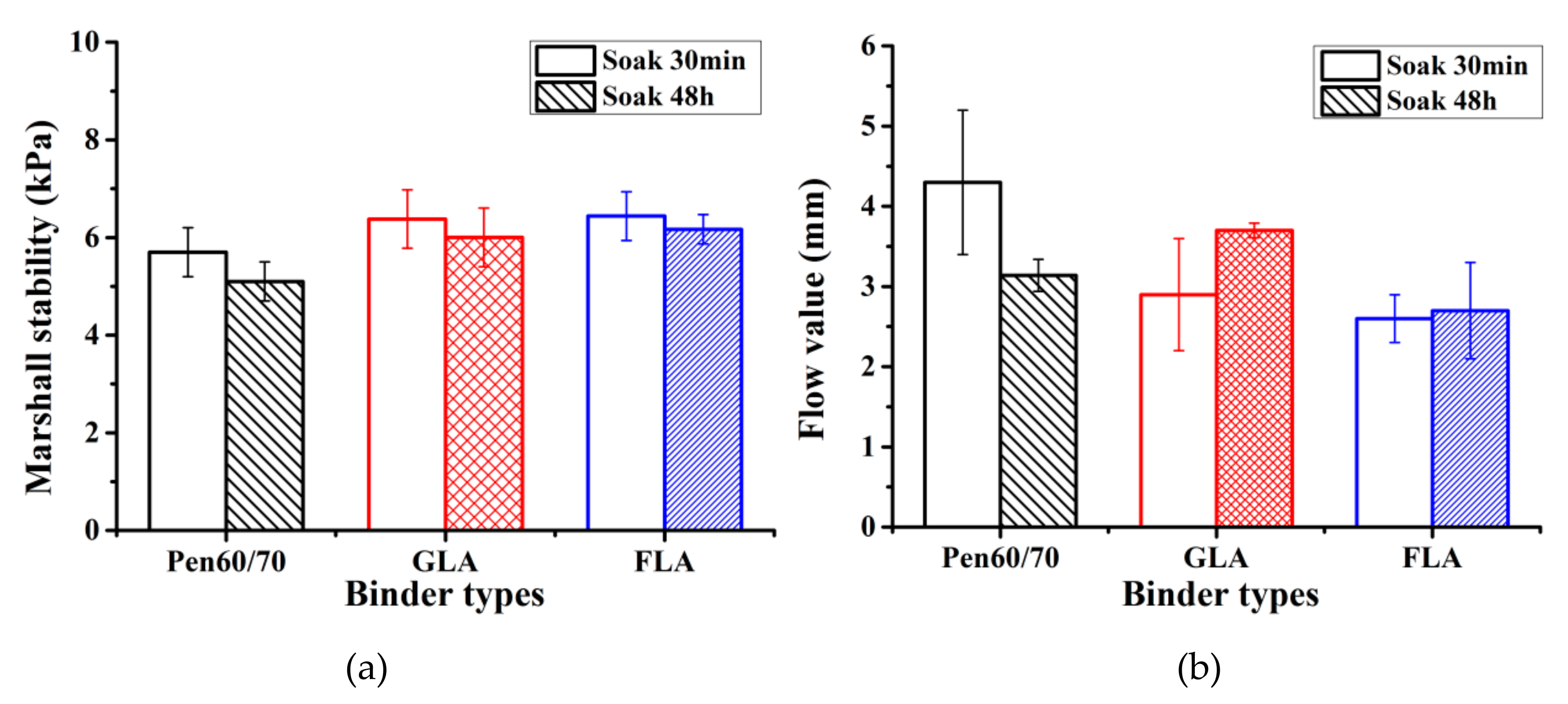

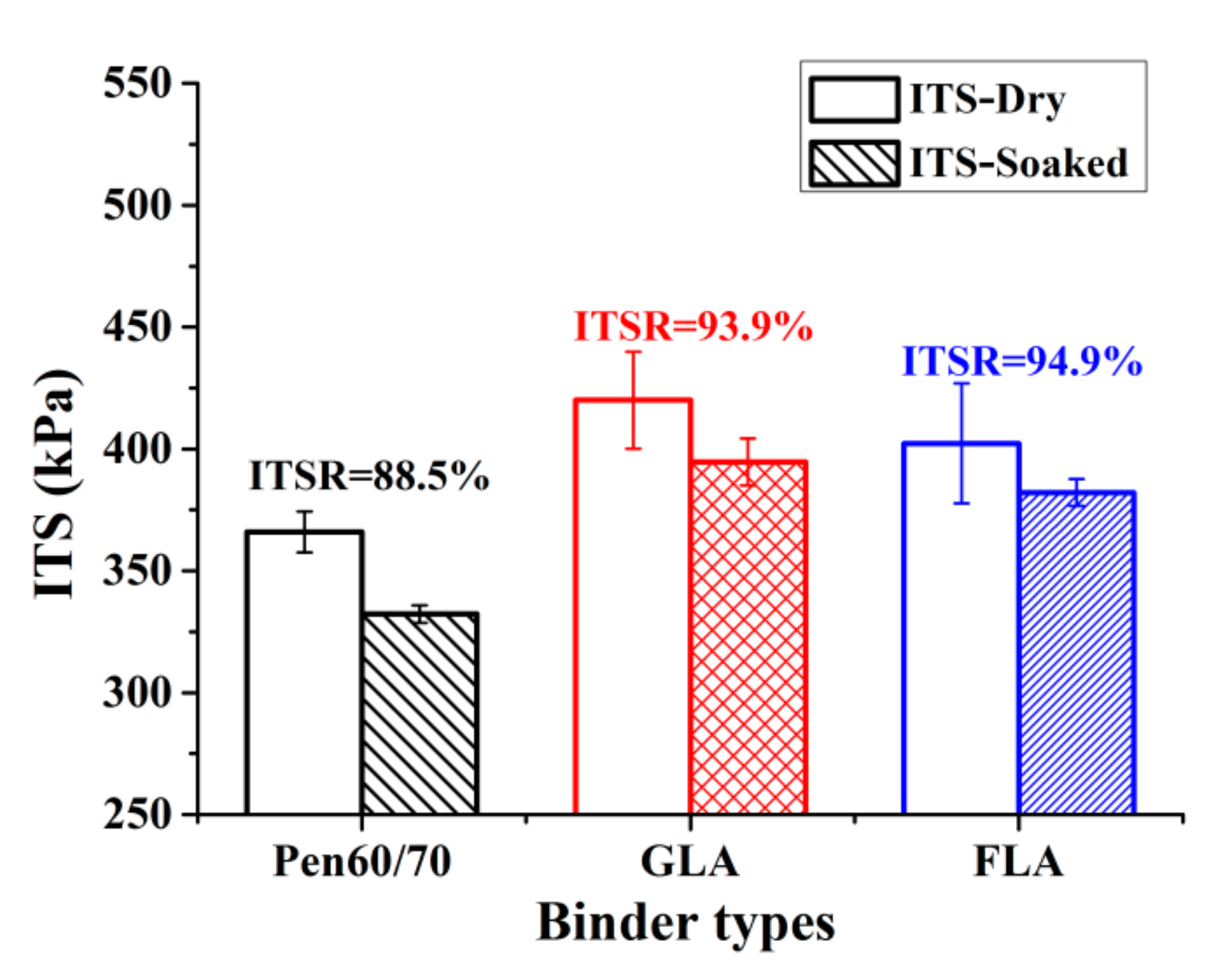
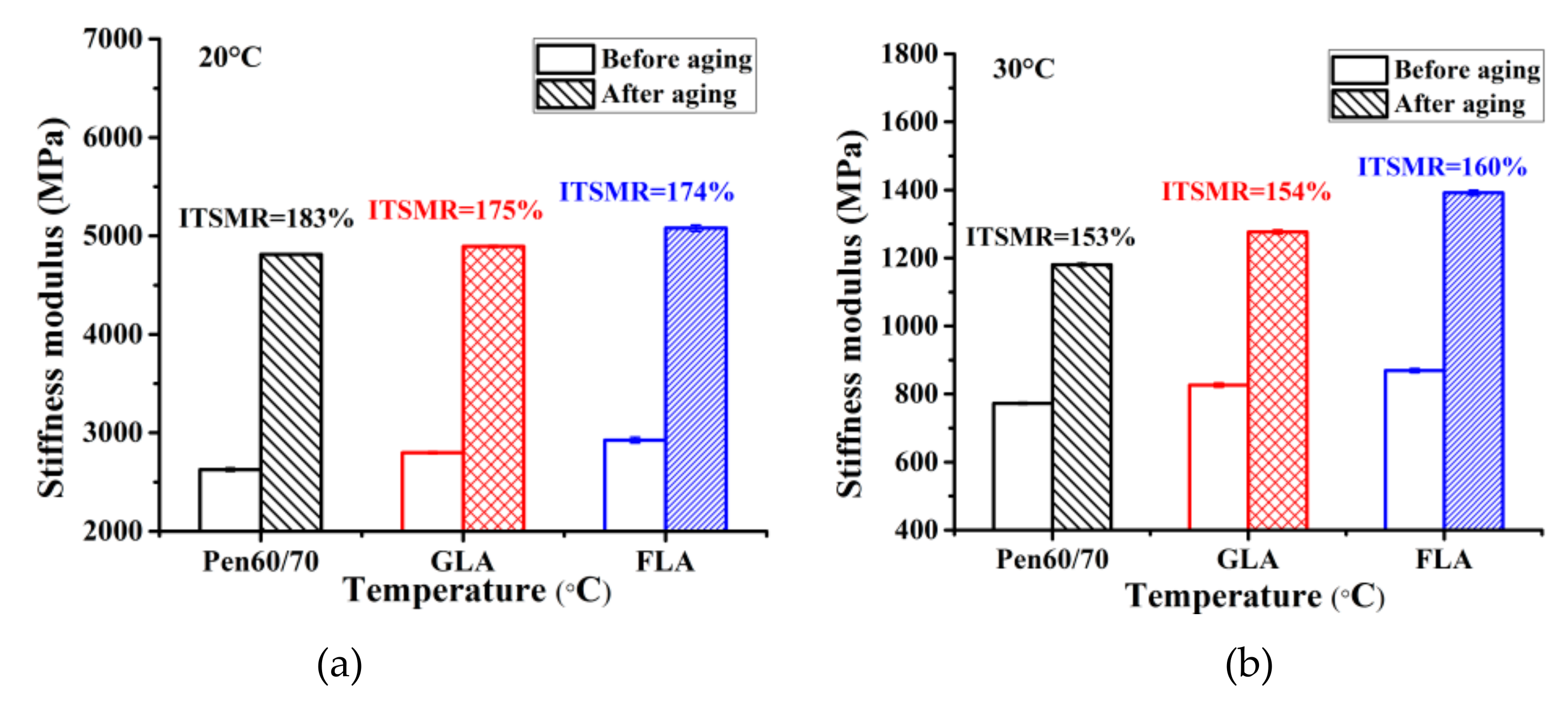
| Test Items | Unit | Value |
|---|---|---|
| Diameter | mm | Less than 6 |
| Ash Content (by weight) | % | 13–23 |
| Heat Resistance | °C | 280 (short time) |
| Ph Value | - | 6.0–8.0 |
| Oil Absorption Rate | % | More than 500 |
| Water Content Rate (by Weight) | % | Less than 5 |
| BS Sieve Size | Design Data (%) | Passing Requirement (%) |
|---|---|---|
| 14 mm | 100 | 100 |
| 10 mm | 96 | 92–100 |
| 5 mm | 35 | 28–42 |
| 2.36 mm | 26 | 19–33 |
| 75 μm | 9.8 | 7.8–11.8 (including 2% hydrated lime) |
| Binder Types | Jnr | % Recovery | |||
|---|---|---|---|---|---|
| 0.1 kPa (kPa−1) | 3.2 kPa (kPa−1) | Jnr% Diff | 0.1 kPa (kPa−1) | 3.2 kPa (kPa−1) | |
| Pen60/70 | 4.5135 | 5.0070 | 10.95 | 0.70 | -0.45 |
| GLA | 1.7085 | 2.2785 | 34.50 | 9.65 | 1.80 |
| FLA | 0.5375 | 1.2340 | 129.50 | 30.50 | 10.70 |
| Binder Types | −6 °C | −12 °C | −18 °C | |||
|---|---|---|---|---|---|---|
| Stiffness (MPa) | m-value (× 10−2) | Stiffness (MPa) | m-value (× 10−2) | Stiffness (MPa) | m-value (× 10−2) | |
| Pen60/70 | 175 | 32.7 | 280 | 28.0 | 541 | 19.9 |
| GLA | 83 | 37.5 | 153 | 31.0 | 306 | 26.5 |
| FLA | 76 | 40.2 | 126 | 32.8 | 283 | 29.2 |
| Parameters | Pen60/70 | GLFMA | FLFMA | |
|---|---|---|---|---|
| Sigmoidal Function | δ (Pa) | −0.55919 | 10.20935 | 20.22812 |
| Α (Pa) | 8.71694 | 43,589.56262 | 58,492.23025 | |
| B (-) | 0.25486 | 0.31567 | 0.80050 | |
| γ (-) | −0.45159 | −0.15908 | −0.15820 | |
| R2@|G*| | 0.99942 | 0.99696 | 0.99743 | |
| WLF Formula | C1 (-) | −8.82557 | −17.75624 | −17.37443 |
| C2 (-) | 138.09993 | 2.36250 | 2.07013 | |
| Sample ID | Mp (g/mol) | Mn (g/mol) | Mw (g/mol) | Mz (g/mol) | Đ (-) |
|---|---|---|---|---|---|
| Pen60/70 | 917 ± 9 | 682 ± 27 | 2371 ± 575 | 9105 ± 3476 | 3.4619 ± 0.7065 |
| GLA | 672 ± 175 | 606 ± 17 | 1917 ± 81 | 6049 ± 507 | 3.1619 ± 0.0456 |
| FLA | 674 ± 162 | 565 ± 1 | 1864 ± 30 | 6040 ± 107 | 3.3020 ± 0.0485 |
| Binder Types | Strength (kPa) | Flow Values (mm) | |||
|---|---|---|---|---|---|
| Soak (30 min) | Soak (48 h) | RS (%) | Soak (30 min) | Soak (48 h) | |
| Pen60/70 | 5.7 ± 0.4 | 5.1 ± 0.5 | 89.5 | 4.26 ± 0.9 | 3.14 ± 0.2 |
| GLA | 6.4 ± 0.6 | 6.0 ± 0.6 | 94.1 | 2.90 ± 0.7 | 3.70 ± 0.1 |
| FLA | 6.4 ± 0.3 | 6.2 ± 0.5 | 95.8 | 2.62 ± 0.3 | 2.70 ± 0.6 |
| Binder Types | Dry Samples (kPa) | Freeze Samples (kPa) | ITSR (%) |
|---|---|---|---|
| Pen60/70 | 366 ± 8.4 | 332 ± 3.6 | 88.5 |
| GLA | 420 ± 19.9 | 395 ± 8.4 | 93.9 |
| FLA | 402 ± 24.5 | 382 ± 5.6 | 94.9 |
© 2019 by the authors. Licensee MDPI, Basel, Switzerland. This article is an open access article distributed under the terms and conditions of the Creative Commons Attribution (CC BY) license (http://creativecommons.org/licenses/by/4.0/).
Share and Cite
Wang, D.; Cai, Z.; Zhang, Z.; Xu, X.; Yu, H. Laboratory Investigation of Lignocellulosic Biomass as Performance Improver for Bituminous Materials. Polymers 2019, 11, 1253. https://doi.org/10.3390/polym11081253
Wang D, Cai Z, Zhang Z, Xu X, Yu H. Laboratory Investigation of Lignocellulosic Biomass as Performance Improver for Bituminous Materials. Polymers. 2019; 11(8):1253. https://doi.org/10.3390/polym11081253
Chicago/Turabian StyleWang, Duanyi, Zhiwei Cai, Zeyu Zhang, Xinquan Xu, and Huayang Yu. 2019. "Laboratory Investigation of Lignocellulosic Biomass as Performance Improver for Bituminous Materials" Polymers 11, no. 8: 1253. https://doi.org/10.3390/polym11081253
APA StyleWang, D., Cai, Z., Zhang, Z., Xu, X., & Yu, H. (2019). Laboratory Investigation of Lignocellulosic Biomass as Performance Improver for Bituminous Materials. Polymers, 11(8), 1253. https://doi.org/10.3390/polym11081253







